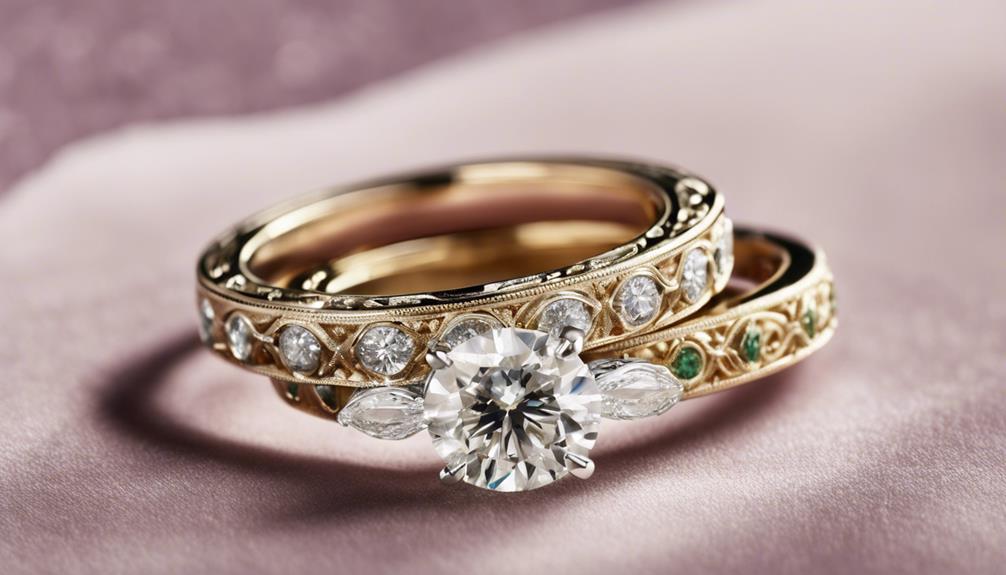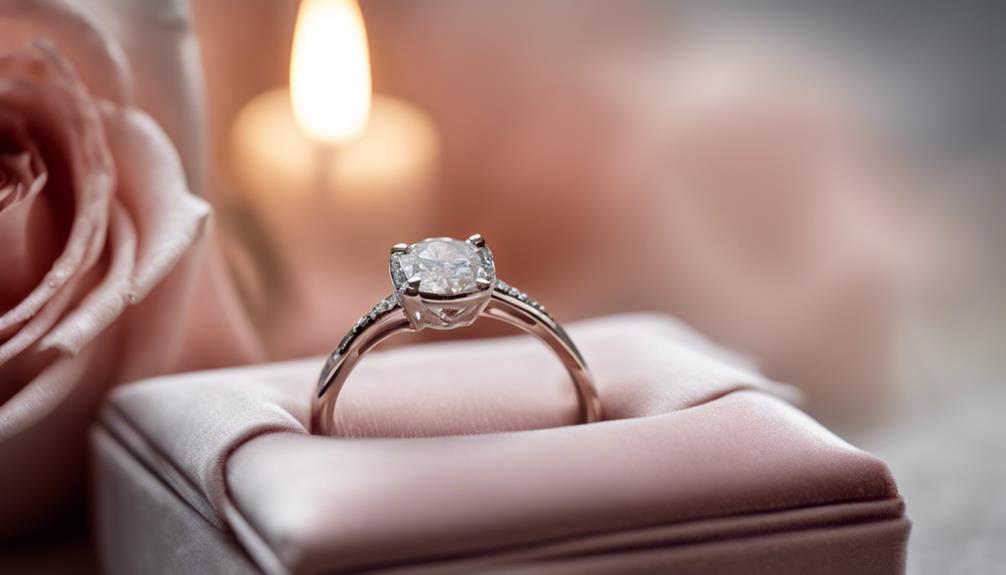When selecting an engagement ring, striking the perfect balance between beauty and durability is essential. Softer alloys like common platinum may bend and lose shape, compromising the ring’s structure. Opt for stronger alloys like platinum-iridium to guarantee longevity. Intricate designs can weaken structural integrity, increasing the risk of losing diamonds. Regular maintenance and periodic inspections by professionals help catch potential issues early. Consider hypoallergenic materials like platinum if allergic reactions are a concern. Proper care, including gentle cleaning and mindful storage, keeps your ring looking its best. Exploring all aspects of engagement rings will enhance your ring’s lasting value.
Common Structural Problems

When it comes to engagement rings, structural problems are a frequent issue that can jeopardize the security of the diamond. Many diamond engagement rings suffer from structural issues because their designs often prioritize beauty over durability. This can lead to wear and tear, which compromises stability and risks diamond loss.
It’s essential to recognize that the engagement ring design plays a significant role in how well your ring withstands the test of time.
You might notice that rings made from softer alloys, like common platinum, tend to bend or lose shape with minimal wear. This is especially true if the ring isn’t engineered for absolute rigidity and stability.
To protect the sentimental value of your ring, you should consider designs that over-engineer for strength. Techniques like soldering with durable materials or using bezel settings can enhance the ring’s security and longevity.
Don’t forget the importance of periodic inspections. Regularly having your ring checked by professionals guarantees any potential design flaws are addressed before they become severe.
Material Selection Impacts
Addressing structural problems often starts with evaluating the materials used in engagement rings. When choosing a ring, you need to take into account the durability of the metal. Softer alloys, like those found in typical 90% platinum, can bend easily, risking the security of the precious stones.
Opting for stronger alloys such as platinum-iridium or platinum-cobalt enhances both durability and performance, guaranteeing your engagement ring stands the test of time.
White gold is a popular choice but be mindful of its composition. It often contains nickel, which can cause allergies in individuals with metal sensitivities. If you’re prone to skin reactions, platinum or sterling silver might be better alternatives to avoid discomfort.
The higher the nickel content in white gold, the greater the chance of irritation, so it’s essential to understand what’s in your ring.
Regular inspections and maintenance are significant to preserve your ring’s integrity. By focusing on material quality, you guarantee the long-term stability of your engagement ring, keeping its beauty and sentimental value intact.
Choosing the right metal not only boosts durability but also provides peace of mind, letting you cherish your ring for years to come.
Design Vs. Durability

Striking a balance between the eye-catching design and long-lasting durability of an engagement ring is vital for ensuring its longevity. When selecting engagement rings, you might be tempted to prioritize intricate, delicate designs. However, these designs can compromise design stability and diamond durability.
For instance, rings using only two claws to hold a diamond may look elegant but often face structural integrity issues, leading to diamonds becoming loose or even falling out after just two months of daily wear.
To prevent these issues, consider rings that incorporate robust engineering solutions. Features like a strong underbezel can greatly enhance diamond stability and withstand everyday activities.
It’s also essential to choose the right materials. Softer alloys, like certain low-grade platinum compositions, are more prone to bending and damage, so opting for harder alternatives can improve the ring’s performance.
Regular inspections by a professional jeweler are key to maintaining the ring’s structural integrity over time. These inspections help identify and address any design flaws, ensuring your ring remains secure and beautiful.
Maintenance and Repairs
Regular maintenance and timely repairs are crucial for guaranteeing the longevity and beauty of your engagement ring. You should schedule regular inspections with a trusted jeweler to identify any loose stones or damage. These inspections are imperative for catching problems early, preventing more extensive repairs later.
Don’t underestimate the importance of cleaning your ring regularly. Removing the buildup of products or bacteria not only keeps the ring sparkling but also prevents skin irritation. Use a gentle cleaning method recommended by your jeweler, and avoid harsh chemicals that could damage the ring’s materials.
Sometimes, resizing may become necessary to guarantee a comfortable fit. Whether due to weight changes or discomfort, many jewelers offer resizing services. This adjustment can greatly enhance your daily comfort without compromising the ring’s structural integrity.
Remember to take care when wearing your ring. Avoid activities like gardening or swimming, which can lead to unnecessary damage.
When not wearing it, store your ring in a safe, dry place to maintain its condition.
Preserving Sentimental Value

Amid the hustle of daily life, it’s easy to forget the deep sentimental value an engagement ring holds. It’s more than just a piece of jewelry; it’s a symbol of your unique bond and the journey you’ve undertaken together. When you wear the ring, you’re reminded of its original engagement moment, filled with love and promise.
Preserving this sentimental value involves caring for both its physical and emotional aspects. To maintain the ring’s condition, regular cleaning and inspections are essential. This not only preserves its appearance but also prevents accumulated wear, ensuring the ring remains a cherished keepsake.
Personalizing it with engravings or meaningful stones can further deepen its emotional significance, reflecting the personal story it holds and the thoughtfulness behind its selection. Discussing the care and attention that went into choosing your ring can also enhance appreciation within your relationship.
Recognizing its story and the intentions behind it reinforces its importance beyond just a material object. Additionally, exploring alternative expressions of commitment through unique designs or shared experiences can complement the ring’s sentimental value, emphasizing the relationship’s journey and the love you share.
Conclusion
In choosing an engagement ring, focus on materials and craftsmanship to guarantee longevity. Don’t let beauty overshadow durability; opt for stronger alloys like high-grade platinum or gold. Consider designs that balance aesthetics and sturdiness. Regular maintenance and timely repairs can prevent issues, preserving your ring’s integrity. By making informed choices, you’ll protect its sentimental value, guaranteeing it remains a lasting symbol of love and commitment. Embrace this knowledge and cherish your ring for years to come.



